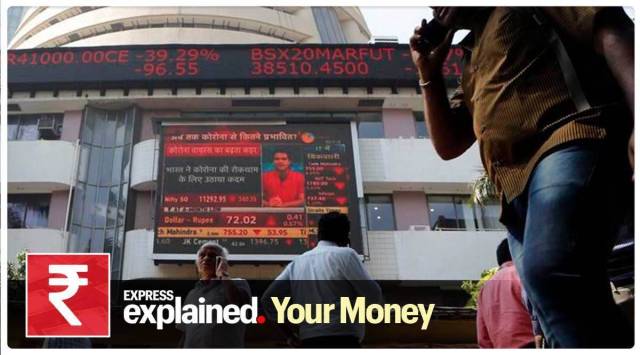- India
- International
Falling markets: How much longer, and how to invest until they recover?
Since the RBI announced its rate hike on May 4, the Sensex has fallen 4.8%. By comparison, the mid-cap and the small-cap indices are down 8.9% and 10.7% respectively.
 Since the RBI announced its rate hike on May 4, the Sensex has fallen 4.8%. By comparison, the mid-cap and the small-cap indices are down 8.9% and 10.7% respectively.
Since the RBI announced its rate hike on May 4, the Sensex has fallen 4.8%. By comparison, the mid-cap and the small-cap indices are down 8.9% and 10.7% respectively.
Corrections in the stock market over the last six weeks, volatility, and broader concerns around inflation have been unnerving for investors, who had enjoyed a bull run in the last one-and-a-half years.
The big concern
Investors have been calling brokers, advisers and fund managers about when the good times will return. Over the last one week, at least three equity market investors have told The Indian Express that their portfolio is down 10–20% in one month. There is a sense of despair among these investors, who have turned day traders, and also new investors who had entered the markets thinking this would help them make money daily.
The stimulus withdrawal and two rate hikes by the US Federal Reserve — 25 basis points in March followed by 50 bp in May — have led to a sharp outflow of funds from emerging markets to the US. Added to that, the off-cycle surprise rate hike of 40 bp by the Reserve Bank of India on May 4, and its commentary with regard to inflation and more rate hikes over the following days, have kept the markets under sustained pressure.
The fall

Since the RBI announced its rate hike on May 4, the Sensex has fallen 4.8%. By comparison, the mid-cap and the small-cap indices are down 8.9% and 10.7% respectively.
Among sectors, auto is the only index that is trading over its closing on May 2, while some other sectoral indices are down by more than 10%. The metal index at BSE has been the biggest loser (down 18.7%) while consumer durables (12.5%), power (10.8%) and IT (9.8%) have been other key losers. The decline in net asset values of mutual fund equity schemes has made even these investors worried.
Inflation worries
In its ‘State of the Economy’ report released last week, the RBI stated that while the economy has consolidated its recovery, there are near-term challenges on account of weakening growth, elevated inflation, supply disruptions on account of geopolitical spillovers and financial market volatility stemming from synchronised monetary tightening.
While the prolonged Russia-Ukraine war has resulted in export restrictions by several countries and has resulted in higher food prices, especially of wheat and corn and edible oils, crude oil prices continue to remain at elevated levels.
Inflation is a concern not just for India, but has hit multi-decade highs across several economies. CPI inflation was at around 8.3% in April in the US, and surged to 7% in March in the UK, the highest in the data series. Overall, the Euro area’s annual inflation reached a new peak of 7.5% in April, primarily driven by energy and followed by food, alcohol and tobacco, said the RBI report. Among BRICS economies, inflation in China rose to a five-month high of 2.1% in April as supply pressure worsened due to lockdowns.
This has resulted in a sharp sell-off across financial markets worldwide since April. The Sensex is down 10.5% since April 4, when it closed at 60,611.
Recovery or not
There is a general sense among leading market experts that the broad indices may remain under pressure in the near term on account of inflation concerns, FPI outflows and overall domestic and global growth concerns. The rise in interest rates on account of inflation is likely to raise the cost of capital and working capital requirements, and may put some pressure on the margins of companies, which may impact their profitability and share prices over the next couple of quarters.
Given that perspective, investors need to be careful while taking positions for the short term. Entry in the markets has to be with a view of three to five years, as many feel that the economy is witnessing a lot of activity on the ground and it will start reflecting in the markets over the next 2-3 years.
A major reason for the current correction is selling by FPIs and reduction in domestic buying. “A drop in FPI selling will be an important reason for the bounce. For this, the actions to be undertaken by the US Fed and the RBI in June will be an important factor. Moreover, we should note that the fiscal measures announced by the Indian government to control inflation are positive for the domestic market,” said Vinod Nair, Head of Research, Geojit Financial Services.
The market has seen several ups and downs in the last 30 years. The current downturn will also pave the way for the return of bulls once the economy revives and foreign investors return.
No guarantee on equity
Investors worried about their portfolio value decline over the last one month should understand that equity is not a monthly guarantee return product, but a risk-bearing investment category that is subject to short-term volatility. So, only an amount that can be kept invested for at least 3-5 years should be put into equities. Also, they should keep in mind that mid-cap and small-cap companies are more vulnerable and subject to higher correction when the market conditions are adverse. So, in times of volatility, it is better to take refuge in blue chip companies, or they must invest in large cap mutual fund schemes or balanced advantage funds.
Newsletter | Click to get the day’s best explainers in your inbox
More Explained
Must Read
EXPRESS OPINION
Apr 23: Latest News
- 01
- 02
- 03
- 04
- 05






































